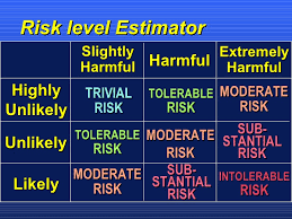
Risk Assessments
Under current health and safety legislation (Section 19 of the Safety, Health and Welfare at Work Act (No. 10 of 2005)) all employers and persons in control of workplaces are required to identify the hazards in the workplace under their control and to assess and control the risks presented by these hazards in so far as is reasonably practicable.
Risk assessments must be completed for all potentially hazardous procedures; for the use of potentially hazardous equipment; for the use of chemicals and for the use of potentially infectious materials.
All assessments should also be subjected to regular review and updating. In the event of a prosecution by the statutory authorities, the failure to complete risk assessments could be used as evidence of noncompliance with safety legislation.
The UCD SIRC Office has completed a number of risk assessments for different categories, which may be used and amended by staff and postgraduates if they are applicable to the work. In the event that these risk assessments do not adequately manage the hazards associated with their work, staff and postgraduates should complete their own risk assessment. There are risk assessment templates also available to help in this regard for biological agents, chemicals, fieldwork, lone working, workshop and machinery/equipment.
(opens in a new window)View completed Risk Assessments by Category here
(opens in a new window)View Risk Assessment Templates Here
For further advice, please contact the UCD SIRC Office ((opens in a new window)sirc@ucd.ie).
5 Basic Steps to Complete a Risk Assessment:
Hazard Definition
‘Hazard’ is defined as the potential to cause harm, while ‘risk’ is defined as the potential of the hazard to cause harm under the actual circumstances of use. The assessment of risk from the hazards identified is based on the linkage of the probability of occurrence with the severity of injury or material loss (the hazard effect) resulting from that occurrence.
Assessing the Risks Using a Risk Matrix
The risk assessment matrix below is used to calculate the risk posed by any hazard by linking the probability of an adverse occurrence with the severity of injury or material loss (the hazard effect) resulting from that occurrence.

Image 1: Simple 3x3 risk matrix example
Risk Rating = Probability x Severity
Probability is determined based on an assessment of how likely it is that an adverse event related to the hazard concerned will occur. Probabilities are graded as:
-
Unlikely: the adverse event being considered will occur only rarely.
- Likely: the adverse event being considered will occur on a frequent basis
- Highly Likely: the adverse event being considered is almost certain to occur
Severity is based on the degree of personal injury or damage to property likely to occur in the event that the adverse event occurs. The severity of the outcome is graded as:
- Slightly Harmful: e.g. superficial injuries; minor cuts and bruises; nuisance and irritation; temporary discomfort; minor infection; minor material damage.
- Harmful: e.g. lacerations; burns; concussion; sprains; minor fractures; dermatitis (temporary); asthma (temporary); long-term discomfort; infection requiring medical treatment; significant material damage.
- Extremely Harmful: e.g. fatality; amputation; major fracture; severe poisoning; cancer; life-shortening condition/disease; deafness; head injuries; eye injuries; substantial material damage.
Risk Rating
- Trivial Risk: No further action is required.
- Acceptable Risk: No additional risk control/reduction measures are required
- Moderate Risk: Further risk control/reduction measures should be considered and implemented where possible. Hazards graded as Moderate Risk must be closely managed.
- Substantial Risk: Further risk control/reduction measures must be identified. If the risk cannot be reduced further then the hazard must be strictly managed and the frequency and duration of the hazard must be reduced to as low a level as practicable along with the number of persons exposed to the hazard.
- Intolerable Risk: All work involving this hazard is prohibited.
Risk Control/ Reduction Methods
The aim of any risk control/reduction measures identified and implemented is to reduce the residual risk from the hazard to as low a level as is reasonably practicable.
Relevant Manuals on Risk Assessments
Persons required to complete risk assessments for chemical, biological, or fieldwork hazards are strongly encouraged to consult the University College Dublin (opens in a new window)UCD Laboratory Biosafety Manual, (opens in a new window)UCD Chemical Safety Manual, and (opens in a new window)UCD Fieldwork Safety Guidelines for detailed safety information. A useful guide to Risk Assessments and Safety Statements is available from the Health and Safety Authority website (opens in a new window)here.
All staff and postgraduate students must be familiar with the contents of the risk assessments that are relevant to their work. Training and further information on workplace safety and risk assessment are available from the University SIRC Office ((opens in a new window)sirc@ucd.ie).